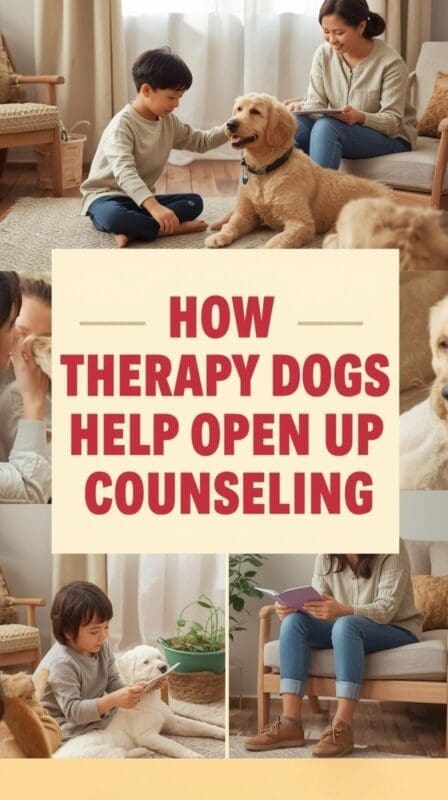Some children arrive at counseling carrying invisible armor — anxiety, fear, or silence that keeps their emotions locked away.
But then, a therapy dog pads softly into the room, tail wagging, eyes kind — and something magical happens.
Walls begin to lower. Words start to find their way out.
That’s the quiet power of therapy dogs in child counseling: they translate safety into something kids can feel.
Here’s how these gentle companions help children open up, connect, and begin to heal.
1. They Turn the Counseling Room Into a Safe Zone
To a child, a therapy room can feel unfamiliar — like a test they don’t know how to pass.
A dog, however, changes the emotional temperature instantly.
Why it works:
- Dogs communicate warmth through body language — not questions or expectations.
- Kids instinctively know: dogs don’t judge, they just are.
- That unconditional presence makes the space feel less clinical and more like a home.
Therapeutic note:
A therapy dog acts as a “co-regulator” — their calm heartbeat and slow breathing influence the child’s nervous system, creating a physiological sense of safety before words are even spoken.
2. They Model Trust and Connection
Many children in therapy struggle to trust adults or new environments.
Dogs make trust visible.
How it helps:
- The therapist demonstrates gentle, respectful care toward the dog — modeling what safe relationships look like.
- Kids watch the dog’s reactions and learn to interpret emotional cues.
- Over time, they project that safety onto the therapist — building relational bridges naturally.
Example:
A shy child who avoids eye contact may first pet the dog while glancing at the therapist — a small but powerful moment of shared connection.
3. They Break Through Silence
When words are too heavy, a dog gives permission to speak — or not to.
In practice:
- A child may narrate their thoughts while brushing the dog’s fur (“I think he gets nervous too sometimes”).
- They can “talk to” the dog first, easing into communication.
- The dog’s quiet presence reduces performance anxiety and social pressure.
Therapist benefit:
Therapy dogs serve as conversational catalysts, especially for children with selective mutism, trauma, or neurodivergent communication styles.
4. They Encourage Emotional Expression Through Play
Play is how children process the world — and therapy dogs make that play feel purposeful and safe.
Examples:
- Tossing a ball can open dialogue about taking turns or following rules.
- Teaching the dog a trick builds confidence and mastery.
- Reading aloud to the dog (a popular intervention) boosts self-esteem without fear of judgment.
SEL crossover:
Play-based activities with therapy dogs develop empathy, patience, and social awareness — all core emotional learning goals.
5. They Help Kids Learn About Feelings (Without Overwhelm)
Dogs mirror emotional energy in ways that kids can observe and understand.
Example:
When a child gets loud or agitated, the dog may step back or lower their head.
The therapist can gently narrate:
“See how Max walked away? He’s showing us that loud voices make him a little nervous — kind of like when we feel too much all at once.”
Why it works:
This externalizes emotion — teaching regulation and empathy without shame.
6. They Build Confidence and Autonomy
Interacting with a therapy dog gives children opportunities for success.
How:
- Giving commands like “sit” or “stay” provides immediate, nonjudgmental feedback.
- Completing simple caregiving tasks (refilling water, brushing) fosters responsibility.
- Positive responses from the dog reinforce the child’s sense of competence and influence.
Result:
Confidence built in these small relational exchanges often generalizes to school, friendships, and family interactions.
7. They Offer Comfort During Emotional Processing
When children cry, withdraw, or relive trauma, the dog’s role becomes profoundly simple — to stay.
Why this matters:
- The dog’s nonverbal empathy models safe proximity during distress.
- Physical touch (fur texture, gentle weight) activates oxytocin, reducing cortisol.
- The dog’s steady breathing provides sensory grounding when words are too much.
For grief work:
Many children describe therapy dogs as “helpers for sad days.” They become living metaphors for support that doesn’t demand fixing.
8. They Make Therapy Feel Joyful Again
Healing doesn’t have to be heavy.
The wag of a tail, a shared laugh, or a moment of softness can reintroduce joy into spaces that once held only pain.
Why it matters:
Positive affect broadens emotional capacity. When kids experience laughter or warmth in therapy, they begin associating healing with hope — not hardship.
Therapist reflection:
Joy isn’t distraction; it’s resilience in action. Therapy dogs embody that truth every day.
Final Thoughts
Therapy dogs help children find their voices — not by asking questions, but by offering presence.
Their calm energy, unconditional acceptance, and instinctive empathy make emotional openness possible long before language catches up.
In a world where so many kids feel unseen or unheard, a dog’s quiet understanding says everything:
“You’re safe. You belong. You can be yourself here.”
For more resources, explore Therapy Dog Decor Ideas and The Emotional Benefits of Therapy Dogs in Counseling Spaces.

About the Author
Hi, I’m Eve, a former school counselor with a master’s degree in School Psychology and a passionate advocate for children and families navigating sensory challenges. As a mom of children with sensory sensitivities, I deeply understand the journey special-needs parents face, and I dedicate myself to researching and sharing practical solutions to help children thrive and feel comfortable in their bodies. My goal is also to empower counselors, therapists, and psychologists with creative strategies and supportive resources to enrich their everyday practice. When I’m not writing or exploring new therapeutic approaches, you’ll find me spending quality time with my family and continually seeking inspiration from everyday moments.



